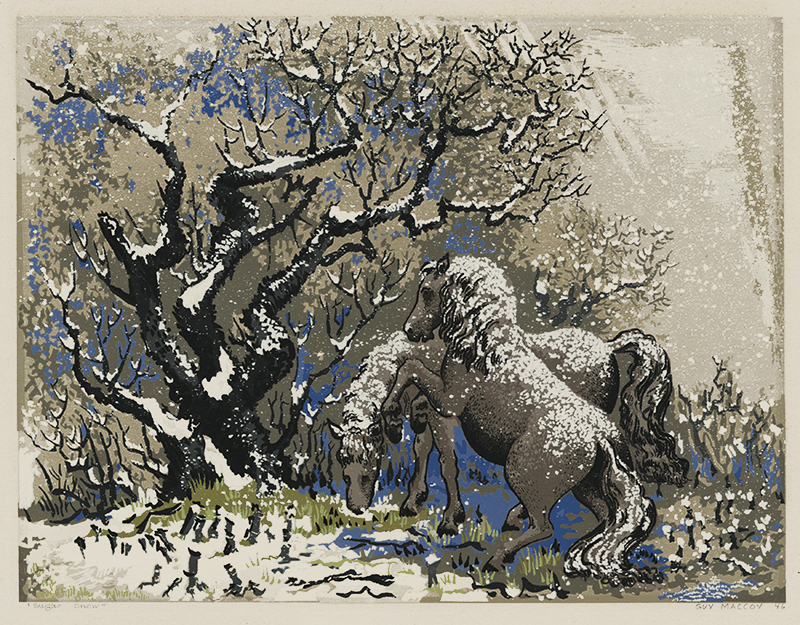
19th, 20th & 21st Century Fine Prints
707-546-7352 · fax 707-546-7924 · web: www.annexgalleries.com · email: artannex@aol.com
Sugar Snow by Guy Crittington Maccoy

Sugar Snow
Guy Crittington Maccoy
Sugar Snow
Guy Crittington Maccoy
1904 - 1981 (biography)Considered by many to be the father of the creative screenprint, Guy Maccoy pushed aside the rigid conventions of commercial art to make way for creativity, opening the doors to experimental screenprinting for countless artists. Here, he's layered the subtle colors of a winter to create a serene landscape, with grazing horses, bare trees and a blanket of new snow.
The title refers to an early, heavy spring snowfall which insulates the bases of sugar maples and prevents early leafing. A heavier sugar snowfall indicates a longer period of sap production, and therefor, a more productive syrup collection.
Guy Maccoy is often referred to as one of the founders of artistic serigraphy, promoting the use of silkscreen - which until the late 1920s had been relegated to commercial works - as a fine art technique unto itself, as promoted in the WPA in the late 1930s. Maccoy was known for his intricate, detailed process of stencil whereby the inks, which sit on the surface of the paper rather than being pressed into the sheet, a la intaglio, are painstakingly separated and overlapped by hue and texture, and applied in careful execution to achieve a painterly quality. His more complex works could employ more than 100 color runs to produce.
Serigrapher, painter, and muralist Guy Crittington Maccoy was born on October 7, 1904, in Valley Falls, Kansas. He began his art studies at the Kansas City Art Institute, taking both day and night courses from Thomas Hart Benton, Randall Davy, Vaclav Vytlacil, and others. Following this, he moved to Colorado Springs to attend Broadmoor Art Academy. Awarded a Tiffany scholarship in 1929, he moved to New York City to continue to study and work as an artist, focusing on mural painting and printmaking.
In 1930 he was awarded a scholarship with the Art Students League, where he worked alongside such artists Jackson Pollock and Rico Lebrun. By this time, Maccoy had established a reputation as a leading fine art silkscreen printmaker (now sometimes credited with popularizing silkscreen as an original art form on its own, removing it from its relegation as a commercial-only technique). He began taking commissions for reproducing other artists' works, with the intent of helping artists earn extra income as the Depression began to take hold.
In 1933 he left the Art Students League to work for the WPA, for whom his wife, Geno Pettit, worked as a supervisor. He enrolled as a muralist, designing the murals for the Central American Arts and Girls Industrial High School, and in 1934, he was commissioned by New York mayor La Guardia to help develop a series of posters for the city. Meanwhile, he experiemented with different mediums and techniques to create the works he dubbed "serigraphs," creating intricately designed, multi-screen works that eventually earned him his first solo exhibit in 1938 at the American Contemporary Art Galleries.
Maccoy graduated from Columbia University in 1939 with a BA in teaching, courses he took while working with the WPA. Upon graduation, he was offered a position at the Poligraphic Lithographic Company in Vermont. After relocating, he and Pettit helped to found "The Workshop," a precursor to the National Serigraph Society, which worked to establish silkscreen as a legitimate fine art. When he and Pettit moved to Los Angeles in 1945, many of the artists in the organization followed; Maccoy remained a member until 1947, when he formed the Western Serigraphy Society. An offer to teach at the Otis Art Institute in 1949 by Millard Sheets heralded a lengthy teaching career for Maccoy throughout the 1950s and '60s, including positions at the University of California, Los Angeles and the Palos Verdes Art Center. After retirement in 1965, he would continue to teach private lessons and workshops.


